
Sometimes you just have to wonder what happens in between the birth of a great idea and the actual carrying out of bringing it to reality. Marlin and Remington put their heads together and came up with an excellent idea. That is, coming up with a levergun more powerful than the .44 Magnum but having less recoil than the .45-70. The cartridge was the .444 Marlin while the platform used was the Marlin Model 336 levergun. As a teenager I often lusted over the pictures of the Marlin Model 336, especially The Texan, pictured in the outdoor magazines of the time. It was available in the nearly legendary .30-30 as well as the highly effective .35 Remington. What could be better for use on deer and black bear in deep woods?
My first Marlin levergun, actually my first firearm ever, was my very own .22 Model 39A purchased with my own money when I was 17. Shortly thereafter it was followed by my first .30-30 Marlin and then when this same model became available in .44 Magnum I gladly purchased one as a companion to my Ruger .44 Blackhawk. It would take a few decades more before I ever found a straight-gripped .35 Remington Marlin Texan. In between, Marlin and Remington introduced the .444 Marlin levergun and cartridge.
What could make a better short range combination for deer and black bear, even hogs, than an easy handling, quick into action levergun with such a relatively powerful cartridge? A Model 336 and a companion cartridge loaded with a 300 grain bullet. However, in 1964 the Model 444 was a 24” rifle with a high Monte Carlo cheek piece, straight-grip stock, two-thirds length magazine tube, and a cartridge loaded with a 240 grain bullet. A 24” barrel is better suited for a long-range rifle and the bullet loaded was not optimal for game larger than deer. It appears Marlin originally saw the Model 444 as a long-range rifle which would be equipped with a scope. Remington originally developed the matching ammunition with a 240 grain bullet. However, they soon began loading the .444 Marlin with a 265 grain jacketed flat nose bullet, which was a significant improvement from the original.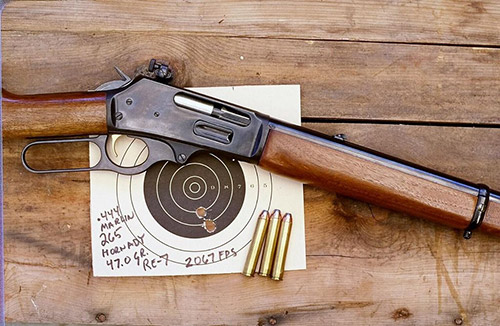
Three shots with the Hornady 265 FP; the .444 Marlin definitely shoots!
Long before I bought a Model 444, I found a new picture of a Marlin Model 336 which was the stuff dreams are made of; at least my youthful dreams. Some enterprising gunsmith had taken a .44 Magnum Model 336 and rechambered it to .444 Marlin. Now, we really had something! I filed this in the back of my mind for future reference.
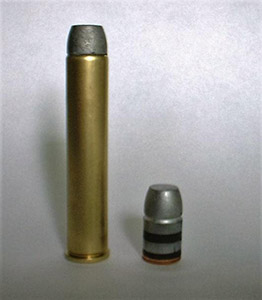 |
It is obvious from this picture how deeply 300 grain bullets must be seated to function through the action of the Marlin .444 levergun. |
The .444 Marlin case, at a length of 2.225”, is not an elongated .44 Magnum as some may think. It is a slightly tapered case going from .470” at the base to .453” at the case mouth, while the 1.285” long .44 Magnum is a straight case of .456” diameter. The nearly straight-walled .444 Marlin case requires a three-die set for reloading just as with a traditional sixgun cartridge case. The case is tapered enough that carbide dies are not available for its reloading. I have been well served by RCBS .444 Marlin dies for more than three decades now. This three-die set consists of a full-length re-sizing die with built-in de-capper, an expander die and a seating/crimping die. Everything utilized to load the .444 Marlin is available in RCBS green. The primers are seated with the RCBS hand-priming tool, powder is dropped from an RCBS Uniflow powder measure which is set with a RCBS Electronic scale. I definitely like and use RCBS products.
There are certainly quite a few powders applicable to loading the .444 Marlin, however most of my chores are handled with three powders, namely Hodgdon’s H322 and H4895, and Alliant’s Reloder 7. My primer of choice is CCI’s #200 Large Rifle Primer. When it comes to reloading as far as I am concerned, there are only two types of brass, Starline and everything else. For decades Starline has been my first choice for all loading of sixgun and semi-automatic pistol cartridges.
Starline’s uniform quality is high and the brass is strong which is especially noticeable when loading .32-20, .38-40, and .44-40 which in other brands can have very thin necks. Now that Starline is beginning to produce rifle brass, I expect the same attributes as found in their pistol cartridges.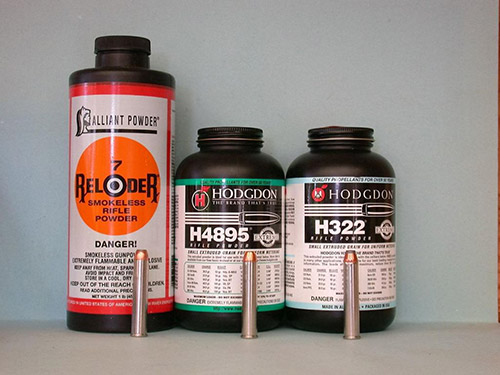
Some of Taffin's favorite powders for loading the .444 Marlin are Alliant’s Reloder 7, and Hodgdon’s H4895 and H322.
The .444 Marlin has now been around for over 50 years. With its arrival, Marlin had not offered a lever gun chambered in a true big-bore rifle cartridge since the .45-70 had been dropped in 1917. Two things happened in the 1970s. Marlin re-introduced the .45-70 and modified the Model 444 by dropping the Monte Carlo cheek piece, and cutting the barrel back to 22 inches. Then just before the close of the 20th century, Marlin introduced the 18-1/2” barreled Outfitter Model 444. I would have like to seen them offer a full-length magazine and we could argue for days about whether a ported barrel was a good thing or not. Regardless, the Outfitter Model 444 was a nice improvement from the original.
In the meantime, I sent an early Model 444 to gunsmith, friend and fellow Shootist, Keith Dehart in Texas asking him to perform some major surgery to come up with a truly custom .444 levergun. The barrel was cut back to 18-1/2” from 24”, a full-length cartridge tube was fitted, the wood was slimmed down, and the factory iron sights were replaced by a receiver sight. It is not quite as easy handling as the Marlin 1894 Trappers which were available with 16” barrels and chambered in .45 Colt and .44 Magnum, however it is very close and provides extra added punch should it be needed.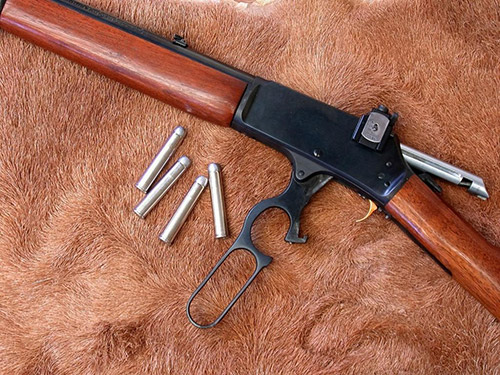
After Keith DeHart shortened this Marlin Model 444 to 18 1/2” and slimmed down the buttstock and forearm, Taffin added a Lyman receiver sight.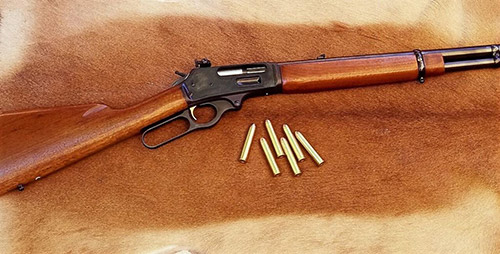
The shortened barrel, slimmed wood, and Lyman receiver sight all combine to make this .444 Marlin an exceptional woods rifle capable of taking anything.
The .444 Marlin brass is not only longer than the .44 Magnum, it is also slightly longer than a .45-70. What this means is overall length is very critical due to the relatively short Model 336 action which was designed for use of the .30-30 and .35 Remington. Keith-style bullets must be crimped over the shoulder or they will seldom feed correctly. My two favorite cast bullets for the .444 Marlin are the NEI #295.429GC which weighs right at about 295 grains and the RCBS #44-300 flat point which is right at 300 grains. The former requires crimping over their shoulder for sure feed. Two heavier cast bullets I also use in the .444 Marlin are Cast Performance Bullet Co.’s 320 grain LBT and the SSK 310 flat-nose bullet designed by J. D. Jones for use in the .44 Magnum.
When it comes to jacketed bullets, the lightest bullet I use in the .444 Marlin is Hornady’s 265 grain jacketed flat point, followed by Speer’s 270 grain Gold Dot, Barnes’ 275 grain offering, and then several 300 grain bullets including the Barnes’ JFP, Hornady’s XTP, and Sierra’s and Speer’s 300 grain JFPs. 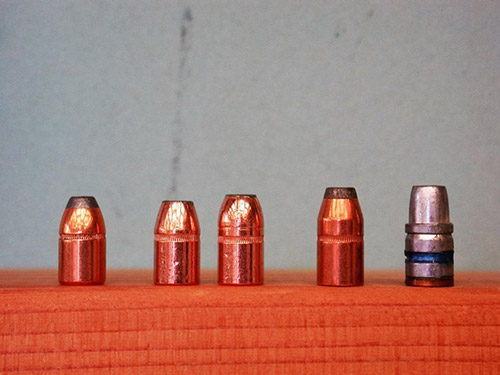
Excellent heavy bullets for use in the .444 Marlin include Hornady's 265 FP, Speer’s 270 and 300 JFNs, Sierra’s 300 FP, and the NEI 295 grain GC
Now let’s look at a few favorite loads. Favorite cast bullet loads include three levels using the 295 grain Keith-style gas checked bullet from the NEI mold. As mentioned this bullet must be crimped over the front shoulder. These are all powerful loads and shoot superbly in my early Micro-Groove barreled Model 444, which as mentioned, has been customized to my specifications by Keith DeHart. For just over 1800 fps I go with 49.5 grains of H 4895, move up to 51.5 grains of the same powder for the 1900 fps, and then my top load at 2,050 fps is assembled with 48.0 grains of H322. My best load with the RCBS #44-300 FNGC is 49.5 grains of H 4895 for just over 1900 fps. With the heavier cast bullets, I use 45.0 grains of Reloder 7 with the 320 grain LBT for 2,065 fps; and with the 310 grain SSK bullet a charge of 51.3 grains H 4895 is a slightly less recoiling load with a muzzle velocity of 1900 fps.
When the Marlin Outfitter arrived, I baptized it with several of my favorite jacketed bullet loads and found a real winner was Hornady’s 300 grain XTP over 48.0 grains of H322. With this load clocking out at 1975 fps from the 18-1/2” barrel and grouping three shots into one-half inch at 50 yards, it has exceptional accuracy for a brush gun cartridge. Speer’s 300 grain JFP over 49.6 grains of H 4895 clocks out at slightly under 1800 fps, it is relatively easy on the shoulder, and gives a one-inch group.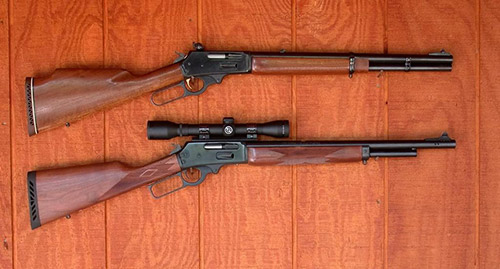
Marlin’s 444 Outfitter, bottom, is the same overall length as the Marlin 444 shortened and slimmed by Keith DeHart.
One issue with the original Model 444 was the fact that it was equipped with Micro-Groove rifling, which everyone knows will not shoot cast bullets; that is, unless one knows the secret. When I picked up the telephone my “Hello” was greeted by, “How in the world did you do that?” And I immediately knew who it was. Several weeks earlier my Texas gunsmith, friend, and fellow Shootist Bob Baer and I were discussing the relative merits of Marlin leverguns. Bob specializes in custom versions of both Ruger single actions and Marlin leverguns with some of the slickest examples anyone is ever likely to encounter.
Even though Bob had had decades of experience with Marlin leverguns, he repeated the same old refrain, namely, “Marlin Micro-Groove barrels will not shoot cast bullets well.” At the time I said nothing, simply waiting for the opportunity to shoot a target with one of my cast bullet loads and send it down to Texas. A week had passed since that target was sent and I had been expecting his call at any time. The problem with the Marlin Model 444 and all other Marlin Micro-Groove leverguns, and particularly the .44 Magnum and .357 Magnum, is not that they will not shoot cast bullets, but rather they will not shoot all cast bullet loads.
Three things are usually necessary to make these barrels shoot, really shoot, with cast bullets. From my experience, I have found cast bullets will shoot if the bearing surface on the bullet is of the right size, if the bullet is a gas checked design, and if the muzzle velocity is in the right range. A 300 grain gas check bullet at 2000 fps made the one-hole, three-shot group on the target I sent to Bob. It was not long after sending this target to Bob that he, Brian Pearce, and I met with executives of Marlin at the SHOT Show. We talked for an hour with the three of us sharing what direction we thought Marlin should go. Some of the things we mentioned were octagonal barrels; short, easy handling carbines; Ballard, or cut rifle barrels; and a return to some of the older calibers such as the .38-55.
Marlin did listen and we soon saw shorter barreled versions such as the .45-70 Guide Gun, the .444 Marlin Outfitter, and the .44 Magnum Prospector, as well as octagonal barrels and the return of the .38-55. And most importantly, Marlin barrels were now cut-rifle, which means they would handle cast bullet loads as well as jacketed bullet rounds.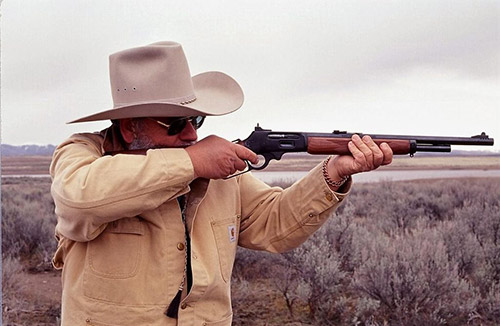
The Marlin Outfitter handles much easier than the original Model 444.
Leverguns are just about perfect “Brush Guns” and we might as well nail down that terminology right now. From the “Taffin Unabridged Dictionary of Sixguns and Leverguns” we have the following definition: “Brush Gun; (brush-gun) n., A large caliber rifle, usually of the lever activating type, with a short barrel, used primarily for easy carrying in brushy country or wooded areas.”
In spite of this easy to understand definition, we still encounter some (including certain writers), who believe a brush gun is for shooting through brush. There is no way any handheld firearm can be made powerful enough to perform the feat of shooting through brush or twigs or saplings and guarantee the bullet will not be deflected on the way to its target. Brush guns are simply compact, easy to carry, fast into action carbines. They are most often found fitted with either the standard factory iron sights or a receiver sight mated up with a bead front sight. The relatively recent innovation that works very well with brush guns is the ghost ring style rear sight. If scoped, brush guns will usually carry a small scope of low-power or a red dot scope, neither of which will distract drastically from their fast handling characteristics.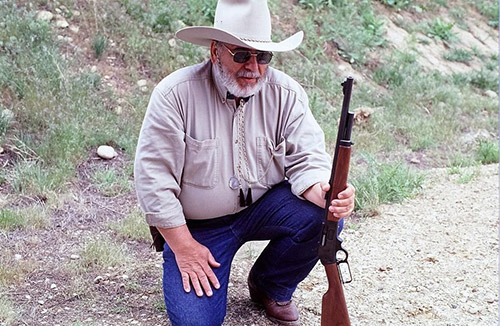
The Marlin Outfitter is compact, easy to carry and use, and sufficiently powerful for anything in North America.
Most game in this country is taken at well under 100 yards, making a good brush gun one of the best choices for most deer hunting, especially in the deep woods found in Western forests and for most eastern hunting. No, it’s not a good choice where long shots are the norm. However, up close with big critters, and often mean, nasty critters, a big-bore brush gun fitted with open sights or good peep sights is an excellent choice. Brush guns must be handy enough for fast action and powerful enough to do the job quickly.
There are basically three classes of brush guns. Those chambered for the .44 Magnum or .45 Colt are great companions for like chambered sixguns and as up close, fast handlin’ carbines for deer, black bear, and feral pigs. The .45-70 will handle anything that walks anywhere; and the .444 Marlin, properly loaded, fits right in between- especially for use on larger deer and in places where black bear and hogs are considered small at 300 pounds.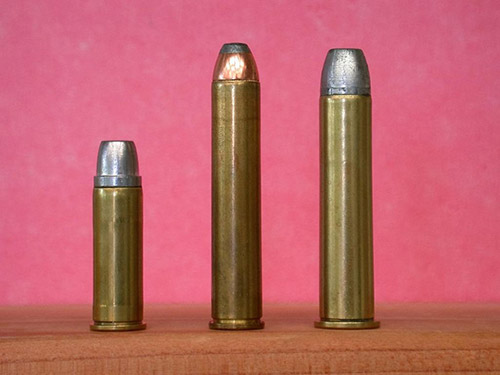
Three woods cartridges compared: The.444 Marlin cartridge case is not only longer than the .44 Magnum it is also longer than the .45-70.
The .45-70 can be used to take anything that walks, however the downside is a shooter pays at the backend with heavy recoil. Many of us do not need a rifle offering the power of the .45-70, yet we may need something more than the .44 Magnum or .45 Colt. That is exactly where the .444 Marlin enters the levergun scene. When compared to the .45-70, it is a kinder, gentler levergun still having plenty of power for use on deer, bear, and hogs, even up close elk and moose. In these situations, the .444 Marlin is just about perfect. What the .45-70 does with 400-grain bullets, the .444 Marlin accomplishes with 300 grain bullets- the result being less recoil and a flatter trajectory.
Test-Fire: Marlin Model 444 18-1/2” .444 Marlin
| Bullet | Load | MV |
| Barnes 275 gr. JFP |
48.0 gr. H322 | 1945 fps |
| Barnes 275 gr. JFP | 46.0 gr. Re-7 | 2081 fps |
| Barnes 275 gr, JFP | 45.0 gr. Re-7 | 2030 fps |
| Hornady 265 gr. JFP | 46.0 gr. H322 | 1787 fps |
| Hornady 265 JFP | 48.0 gr. H322 | 1925 fps |
| Hornady 265 JFP | 51.0 gr. H322 | 2030 fps |
| Hornady 265 JFP | 45.0 gr. Re-7 | 1951 fps |
| Hornady 265 JFP | 51.5 gr. H4895 |
1894 fps |
| Hornady 300 XTP | 46.0 gr. H322 |
1884 fps |
| Hornady 300 XTP | 48.0 gr. H322 |
1974 fps |
| Hornady 300 XTP | 45.0 gr. Re-7 |
2105 fps |
| Hornady 300 XTP | 51.3 gr. H4895 |
1927 fps |
| Sierra 300 gr. JFP | 46.0 gr. H322 |
1833 fps |
| Sierra 300 gr. JFP | 48.0 gr H322 |
1939 fps |
| Sierra 300 gr. JFP | 51.5 gr.H4895 |
1894 fps |
| Sierra 300 JFP | 45.0 gr. Re-7 |
1957 fps |
| Speer 270 GDHP | 46.0 gr. H322 |
1833 fps |
| Speer 270 GDHP | 48.0 gr. H322 |
1938 fps |
| Speer 270 GDHP | 45.0 gr. Re-7 |
1944 fps |
| Speer 300 JFP | 49.5 gr. H4895 |
1791 fps |
| Speer 300 JFP | 51.5 gr. H4895 |
1823 fps |
| Speer 300 JFP | 46.0 gr. H322 |
1882 fps |
| Speer 300 JFP | 48.0 gr. H322 |
1939 fps |
| Speer 300 JFP | 45.0 gr. Re-7 |
1846 fps |
CAST BULLET LOADS:
| Bullet | Load | MV |
| NEI #295.429GC | 49.5 gr. H4895 | 1831 fps |
| NEI #295.429GC | 51.5 gr. H4895 | 1900 fps |
| NEI #295.429GC | 48.0 gr. H322 |
2060 fps |
| CPBC 320 LBT | 45.0 gr. Re-7 |
2065 fps |
| RCBS #44-300GC | 49.5 gr. H4895 |
1906 fps |
| SSK 310 FP | 51.3 gr. H4895 |
1918 fps |
DISCLAIMER: All reloading data in this article is for informational purposes only. Starline Brass and the author accept no responsibility for use of the data in this article.